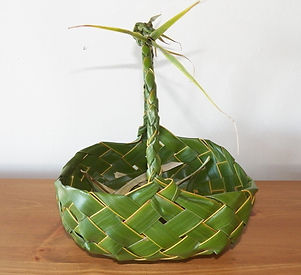Coconut Basketry

The Pacific ocean is vast and filled with islands large and small, high and low. Each island has developed distinctive cultural traditions and the weavers have devised unique ways to fashion coconut fronds into baskets that are completely unique to their island.

In the mid-1970s and 1980s, Lynn learned a wide range of coconut basket styles from master weavers on the islands of Guam, Saipan, Palau, Yap, Pohnpei, Fiji and Tahiti. They represent a legacy of generosity and trust.



Every coconut frond is different. The spacing between the leaflets changes from the base of the frond to the top. And, the length and width of each leaflet differs along the length of the frond and from tree to tree. In order to make a symmetrical basket, you need to trim each leaflet as you work, measuring each one by eye. But even so, each basket is as unique as the frond it is made from.


Weaving with a coconut frond is unlike any other basket tradition. The leaflets - what you are weaving with - are peeled from the central stalk of the frond in a continuous strip. You weave while the leaflets are still green. After the basket if finished it will gradually dry to a tannish cream color.
Usually, you begin a coconut basket at the top and finish at the bottom. The best coconut baskets are woven with fronds that grow toward the middle of the tree. There is a creamy yellowish green shoot in the center that is reserved for very special, finely woven baskets.




Weaving with coconut is like a dance. There is choreography to how you form a basket. There is a rhythm to how you sequence your movements. The dance begins seated on a mat or the ground. You need to be able to use your hands and your arms, press it against your chest to maintain tension, catch it in the crook of your knee for stability, and even use your toes as an anchor. How you hold your body as the basket progresses is key to success.
Styles & origins


These basic basket forms were taught to Lynn by her first teacher Eulalia Harui, who was from Ulithi Atoll in the Central Carolline Islands. They can be made quickly for serving and carrying food.


On the left is a basket style from Tobi Island, Palau. The right is a basket style from Moʻorea, Tahiti.


The basket with the braided bottom is unique to Palau. The basket with the spiral bottom is unique to the Chamorro culture of Guahan (Guam).




This basket is called kopwou and is unique to the island of Pohnpei. It usually takes two new shoots from a large tree to match up the sections needed to make this very difficult basket. After locking three sections on each side, the bottom is woven in a twill weave.
This basket is unique to the island of Palau and is made by splitting each leaflet so half the midrib goes to each side. Then each leaflet is stripped down to about 1/4" i width.



This finely woven basket is called ketekete and is unique to the islands of Fiji. It usually takes two young shoots to match up the 4 sections needed to make this finely woven basket.
Fanciful ornaments can be made using a single leaflet that is folded, twisted and inserted.
It is a little like origami, but using long strips instead of squares!







Click here for a gallery version of coconut baskets with some more explanations on how they are made.
Photographs by Lynn Martin Graton unless otherwise noted.